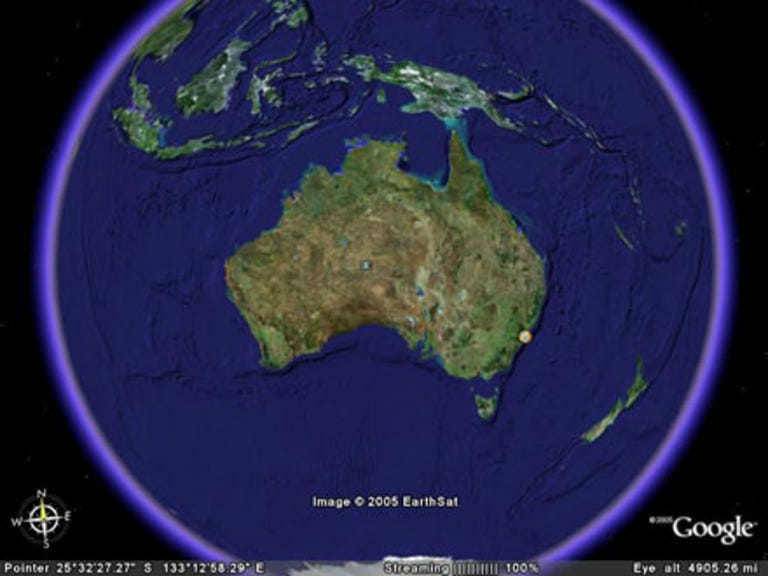 Why You Can Trust CNET
Why You Can Trust CNET Google Earth review: Google Earth
Google has launched an impressive 3D geographic imaging application called Earth useful for education, travel and business. Best of all, it's free.
Occasionally a piece of software comes along that is very, very cool.
The Good
The Bad
The Bottom Line
http://earth.google.comGoogle Earth, a free application that brings a 3D model of the world to your desktop, was launched last week by the California-based search engine giant.
After installing the 10MB application, you are presented with a 3D model of the globe, which you can tilt, pan and spin around with your mouse. Using the scroll wheel lets you zoom in and out with an extraordinary level of detail to high-resolution satellite images of hundreds of cities, giving users a birds-eye view of streets, buildings, parks and landmarks.
 View larger image: Australia |
Type the name of a city into the search bar and Google Earth rockets out of your current location and flies you directly to street level of your next destination. Like any decent geographical information system, Google Earth combines these bitmap satellite images with vector overlays that represent borders, roads and train lines, and a stack of other information.
It would be good to see Google expand its database to include more thorough information on countries outside of the US. Currently, US-based cities have the most data associated with them, such as placemarks for local shops, bars/clubs, chemists, petrol stations and schools.
A large amount of community-generated points can also be displayed, such as Web cams, stadiums and places of interest.
View larger image: Sydney |
You can create your own placemarks with custom icons for personal spots like home, work, your favourite pub or the best beaches in town. You can then save maps as JPEGs and e-mail them to friends through Google Earth's File menu. What's even better than sending a static image, though, is saving locations as very small KMZ co-ordinate files to share with other Google Earth users. This allows users to zoom in (and out) on the sent spot. And if you're in the US, Google Earth can provide directions from one location to another.
Browsing heavily populated US cities gives you the opportunity to switch on 3D buildings, which, although not textured, are really quite amazing. When using this feature, you can adjust the perspective by tilting down from an aerial view to a horizontal view like you're looking down a street and surrounded by buildings. It makes us wonder the possibilities of integrating this technology with gaming down the track -- Grand Theft Auto: Sydney or the ultimate Sim City come to mind.
View larger image: Sydney Cricket Ground / Aussie Stadium |
Before giving it a shot, your PC better have a considerable amount of processing grunt to render Earth's 3D graphics. You'll also need substantial amounts of memory to juggle the massive amounts of satellite imagery that is downloaded on-the-fly. Google recommends at least a 2.4GHz Pentium 4 (or a AMD 2400xp processor), 512MB RAM, 2GB of free disk space and a 3D-capable video card with 32MB of VRAM. We tested it with a PC above and below this configuration with varying results. While it would run on the lower configuration, don't expect smooth operation.
Another downside to the application is that it's very taxing on bandwidth -- just ask our tech department here, days after Google Earth's release. Unfortunately a dialup modem just isn't going to cut it. Google recommends a broadband connection of 768 Kbits/sec or higher. It took just under an hour to clock up over 250MB of downloaded data testing the application on a 12Mbps ADSL home connection. It's certainly great fun wandering around the world with Google Earth. For some interesing locations, have a look through the forums on http://bbs.keyhole.com/boardsKeyhole's Web site -- Google last year acquired Keyhole, developers of the software on which Earth is based.
Download Google Earth from CNET.com.au Downloads here.
View larger image: 3D buildings in New York |
Here are a couple of examples once you've installed Google Earth:


